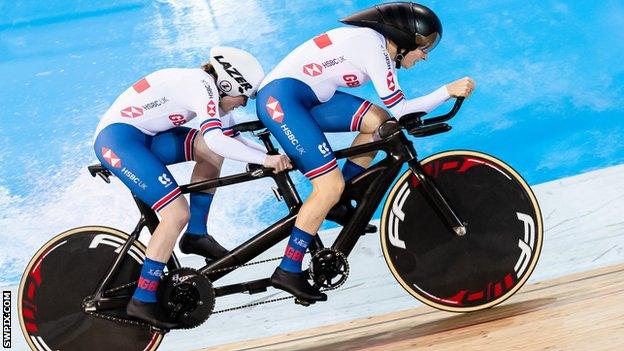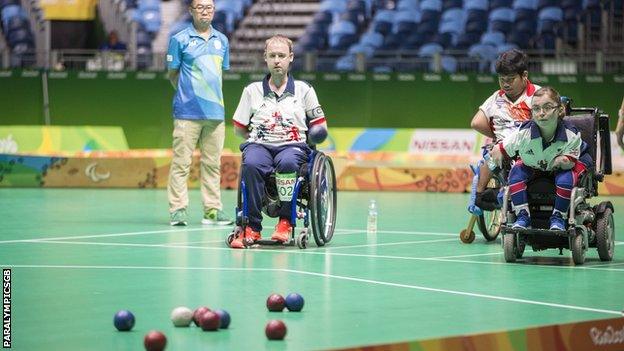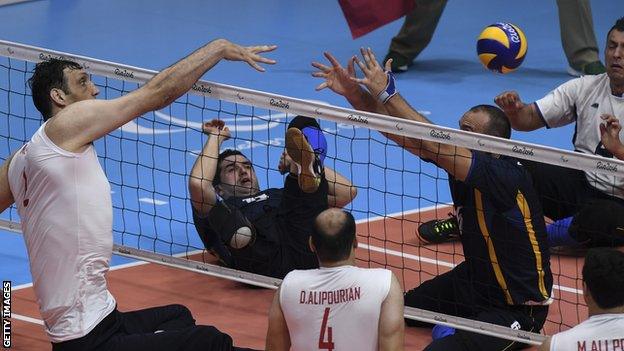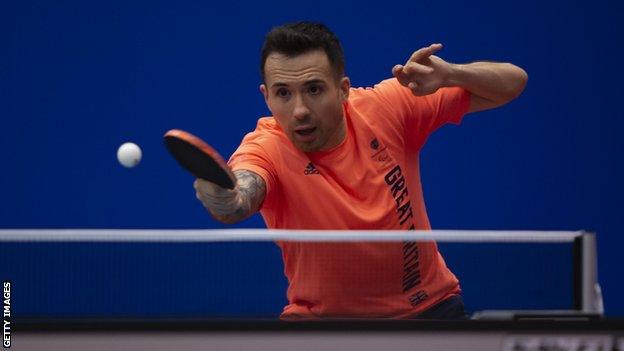Tokyo Paralympics: Sport-by-sport guide
- Published

British tandem riders Lora Fachie and pilot Corrine Hall won gold in the women's B individual pursuit at Rio 2016
Paralympic Games on the BBC |
|---|
Venue: Tokyo, Japan Dates: 24 August-5 September Time in Tokyo: BST +8 |
Coverage: Follow on Radio 5 Live and on the BBC Sport website |
Find out more about the 22 sports in which athletes will be competing for medals at the rescheduled Paralympic Games in Tokyo.
Everything you need to know about the Paralympic classification system can be found here.
Para-archery: In Paralympic archery, archers compete in three classes - W1, open compound and open recurve. Great Britain led the medal table in the sport in Rio 2016.
Para-athletics: Athletics is one of only two sports at the Paralympics, along with swimming, which caters for competitors from all physical impairments groups, visual impairments and those with a learning disability.
Para-badminton: One of the sports making its Paralympic debut in Tokyo, most rules are the same as the non-disabled version, with all events using a best-of-three games format, each of 21 points. Athletes compete in six classes. Wheelchair athletes are classified into WH1 and WH2; standing athletes with a lower impairment in SL3 and SL 4, and upper impairment SU5, and short stature SH6.
Boccia: The sport is played indoors on a court similar in size to badminton with players positioned at one end. Both sides have six balls - one side has red balls, the other blue balls and the aim of the game is to get your balls closer to the white target ball - the jack - than your opponent.

Boccia is one of two Paralympic-specific sports which has no Olympic counterpart and is for athletes with conditions such as severe cerebral palsy and muscular dystrophy that affects all four limbs
Para-canoe: Athletes race over 200 metres in lanes in two types of boats, kayak (K) and va'a (V). The kayak is propelled by a double-blade paddle, while the va'a is an outrigger canoe which has a second pontoon as a support float and uses a single-blade paddle.
Para-cycling: Cycling at the Paralympics includes both track and road cycling. Track cyclists ride either tandem bicycles or bicycles, while road cyclists compete on handcycles, tricycles, tandem bicycles or bicycles. Sarah Storey, who has 14 Paralympic gold medals, is aiming for three more in Tokyo to break Mike Kenny's record tally for a British athlete (16).
Para-equestrian: Equestrian events at the Paralympics consist solely of dressage competition, with riders divided into five grades depending on the nature and extent of their impairment. All athletes compete together, including the physically impaired and vision impaired, and men and women, with the level of difficulty of the test they perform relative to their grade.
Five-a-side football: The game is played using a small ball with a bell inside that makes a noise as it moves to aid the players in their movements. The four outfield players must all wear eyeshades to ensure fair play as some players may be partially sighted. The goalkeeper is sighted.
Goalball: A sport for athletes with visual impairments. All players on the court must be blindfolded and the aim is to roll or throw the ball into the opponents' goal as many times as possible within two halves of 12 minutes.
Judo: Judo at the Paralympics is only open to athletes with a visual impairment. Each competition is based on weight divisions and athletes begin each bout gripped up. B1 athletes have the most severe impairment and wear a red circle on their uniform while athletes with a hearing impairment wear a blue circle on their sleeve.
Powerlifting: There are 10 different weight categories for both men and women. Athletes are classified by bodyweight alone, which means those with different impairments compete for the same medals.
Para-rowing: There are four events on the Paralympic rowing programme, each raced over 2,000m, which is double the length of the races at Rio 2016. Competitors take part in heats and repechages before going on to contest the finals.
Sitting volleyball: The net is lowered to ground level as the players hit the ball over the net sitting down. For a hit to be legal, all players must keep their pelvis in contact with the floor and unlike Olympic volleyball, blocking of the serve is allowed.

Iran have been the dominant force in sitting volleyball for many years
Para-shooting: Both rifle and pistol events are contested at the Paralympics. Targets vary in size depending on the event. In the 10m air rifle event, the whole target is 4.5cm in diameter and the central ring is just half a millimetre across.
Para-swimming: Races take place in a standard 50m pool in the freestyle, backstroke, breaststroke and butterfly disciplines plus medley, over distances which range from 50m to 400m. The programme also features relay races.
Para-taekwondo: The other new sport for Tokyo 2020, taekwondo bouts consist of three two-minute rounds. Kicks to the head are forbidden and punches to the body are not scored, as athletes have different capacities to block. Instead, extra points can be scored for more difficult kicks.
Para-table tennis: A match is played over the best of five sets, with each won by the first player to reach 11 points. If the score in a set reaches 10-10, a player must establish a two-point lead to win it.

Will Bayley will be hoping to add to his Paralympic medal tally in table tennis
Para-triathlon: The event will see athletes compete in three disciplines: 750 metres of swimming, 20km of cycling, followed by a 5km run. For the cycling section of the race, athletes may use a tandem bicycle, handcycle or bicycle, while a wheelchair may be used for the final 5km run to the finish line.
Wheelchair basketball: A men's tournament has featured at every Games since 1960 with a women's event joining in 1968. Players are classified from 1.0 (the most impaired) to 4.5 (the least impaired) and a team can only have 14 points among five players on a court at one time.
Wheelchair fencing: Wheelchair fencing has three disciplines depending on the type of sword used: the foil, the epee and the sabre. Bouts in the first round of the competition are the best of nine hits and competitors are then promoted to a direct elimination where bouts are awarded to the first to reach 15 hits.
Wheelchair rugby: Played indoors on a regulation-size basketball court, wheelchair rugby features mixed teams of men and women playing matches of four eight-minute quarters. Contact between wheelchairs forms an integral part of the game, although making physical contact with an opponent leads to penalisation.
Wheelchair tennis: Wheelchair tennis is broadly similar to the running game with a few important differences, including the ball being able to bounce twice, although the first bounce must be within the court confines.